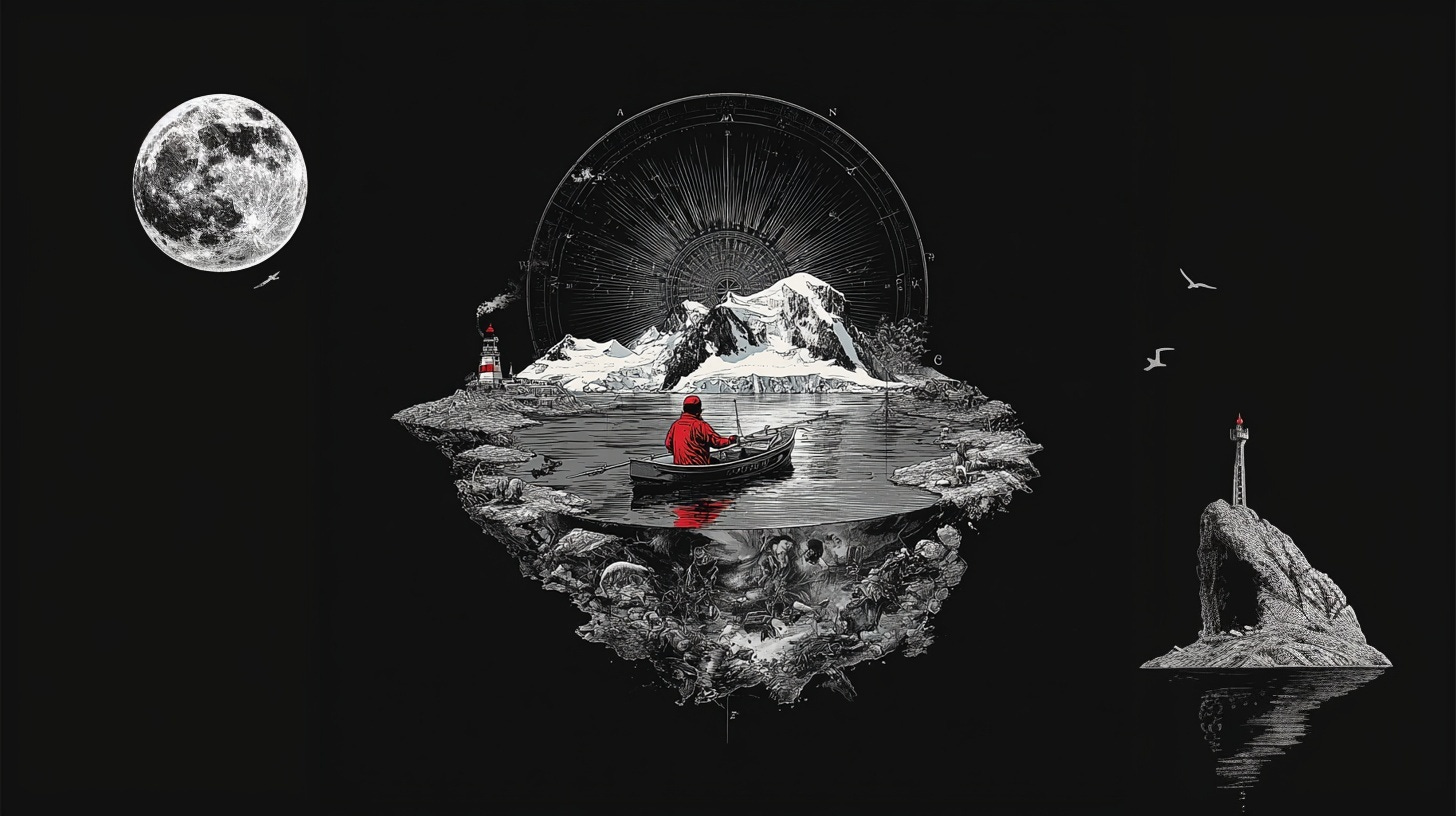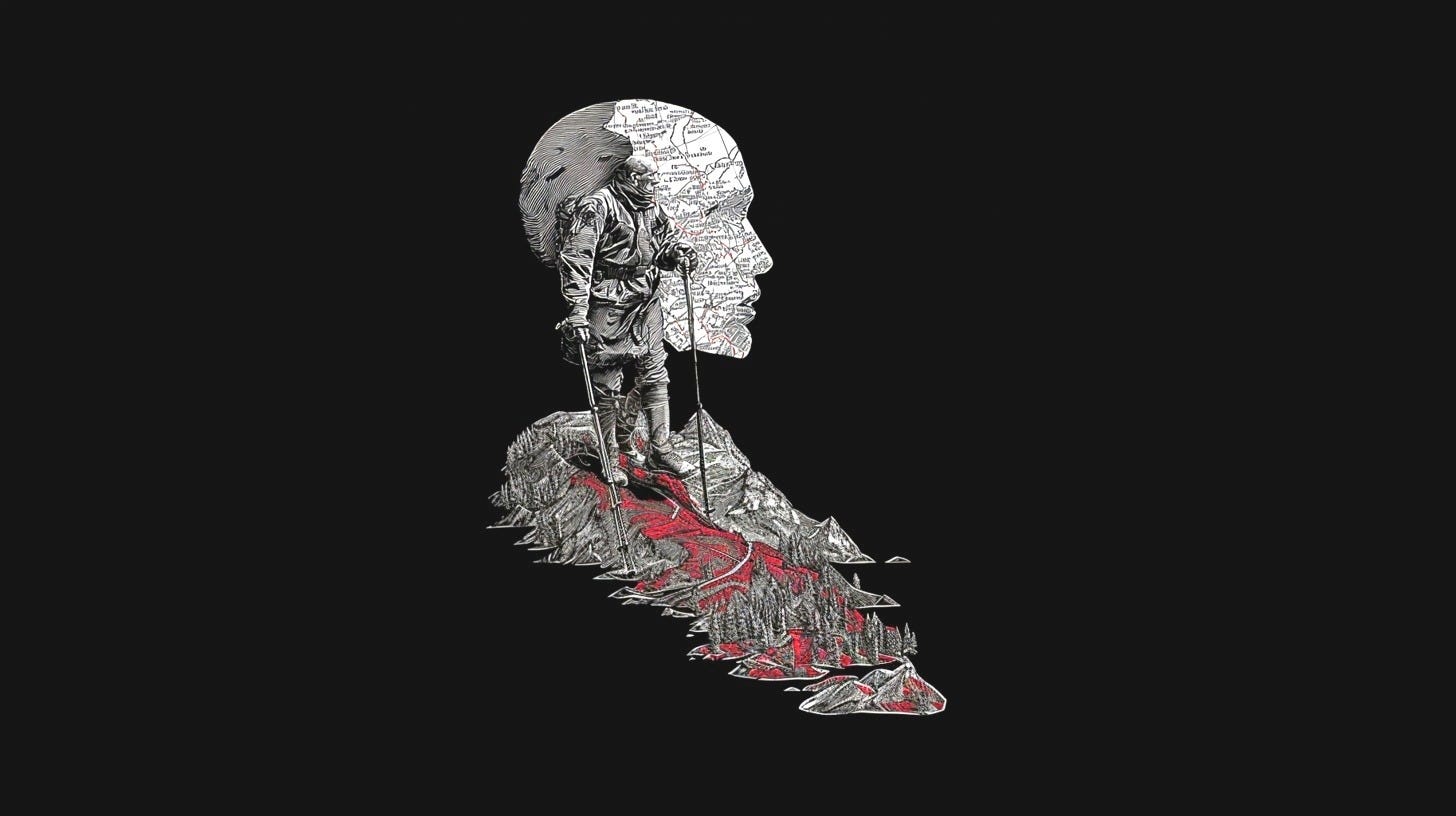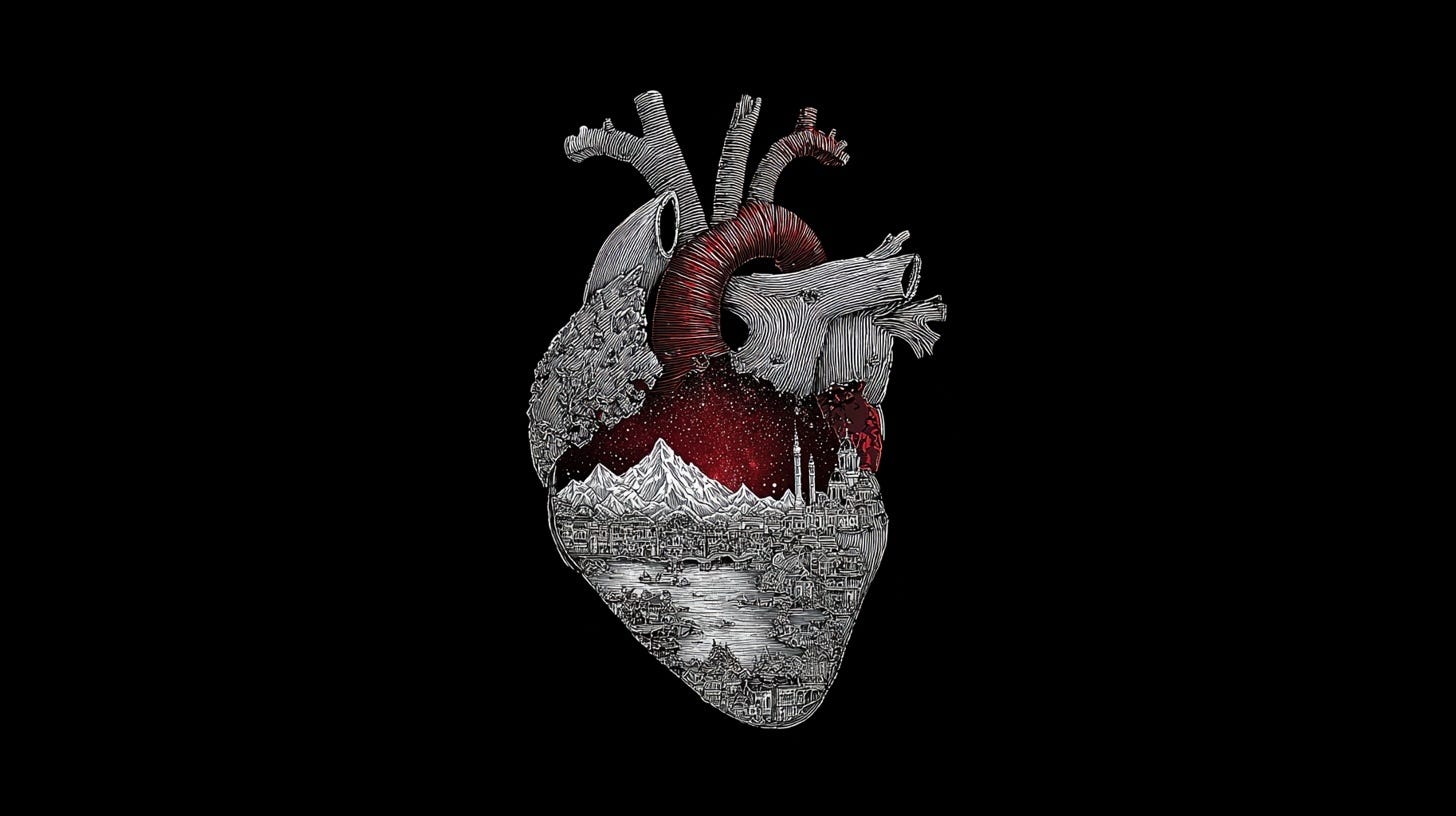Each of us has within a continent of undiscovered character. Blessed are those who act the Columbus to their own soul — Unknown
Spotlight
Erling Kagge is a Norwegian adventurer and the first person in history to reach the North Pole, the South Pole, and the summit of Mount Everest on foot. In 1990, he and fellow explorer Børge Ousland spent 58 days trekking ~800 km over shifting sea ice to reach the North Pole unsupported. Just a few years later, Kagge set off completely alone to ski across Antarctica to the South Pole – 50 days and nights under the midnight sun, dragging a sled of supplies with no radio contact to the outside world. For 1,300 kilometers, he journeyed through an otherworldly silence and cold. “Here stillness is all-absorbing... everything seems eternal and without limit,” he wrote in his journal.
What is the role of silence in our modern lives? Kagge has been described as “a philosophical adventurer, and his book Silence: In the Age of Noise became an international bestseller. In it, Kagge points to something foundational “We live in the age of noise... Silence is almost extinct,” “You must create your own silence.” He describes silence not as an absence of anything, but as a tangible presence – “something... rich; it’s a quality... a key to unlock new ways of thinking. However uncomfortable at times – “to explore your own silence is about making life a bit more difficult... the present hurts” – it is ultimately rewarding. You don’t need to travel to the South Pole to find irt the key is to slow down and listen. “I don’t know how many times I’ve been told that people... experience a lack of time,” whereas “It sounds like such a good excuse, but it isn’t quite correct. We do have enough time. Life is long, if we listen to ourselves often enough, and look up.”
By listening to the “language of nature” the call of the wind, the crunch of snow, the beating of his own heart — the ability to tune in, to play by nature’s rules and learn from its silence, is what Kagge believes can help anyone in their own life challenges. Whether your expedition is launching a new idea into the world, venturing into outer space, or entering the most fearful cave of your inner doubts, the approach is the same: dare to step forward, stay present, and trust the journey to teach you who you are.
The life of a true explorer begins where the certainty of the map ends and the real unknown begins. Kagge teaches us that beyond what is known, beyond the familiar path, beyond our comfort zone, beyond the noise of everyday life, lies a realm of home rich with wonder. “Your own South Pole is waiting.” All you need to do is take that first step into the unknown, and listen to the silence that follows.
I believe it’s possible for everyone to discover this silence within themselves. It is there all the time, even when we are surrounded by constant noise. Deep down in the ocean, below the waves and ripples, you can find your internal silence — Erling Kagge
Technology
AI Robot Reasoning and 3D-Printed Housing
Google DeepMind unveiled Gemini Robotics 1.5, an AI model that gives robots a more intuitive sense of the physical world. Gemini 1.5 enables robots to perceive their environment, plan multi-step tasks, and even use tools without explicit hard-coding – essentially allowing them to “think” before acting. In one demo, a Gemini-powered robot autonomously cleaned a kitchen by identifying dirty dishes, loading a dishwasher, and running it, all on its own. DeepMind frames this as a step toward general-purpose robot assistants that bring AI from the digital realm into our physical daily lives. In the realm of construction, an Australian company introduced “Charlotte,” a six-legged spider-like robot that can 3D-print a 200 m² house in just 24 hours. Charlotte compacts local materials (like sand, soil, or waste mixed with binders) into layered walls – resulting in low-cost, low-carbon structures. This innovation could help address housing shortages with rapid, affordable homebuilding, and the robot’s lightweight, terrain-adapting design is even being eyed for the Moon.
Gemini Robotics & 3D Charlotte
Windowless Jet, eVTOL Record, and Orbital Delivery
A startup called Otto Aerospace revealed the Phantom 3500 business jet – a windowless private plane designed for extreme efficiency. Without structural window cutouts, the smooth carbon-fiber fuselage is lighter and more aerodynamic, cutting fuel burn by about 60% compared to similar midsize jets. In other futuristic flight news, Archer Aviation’s “Midnight” eVTOL air taxi prototype reached 7,000 feet altitude at 120 mph and flew 45 miles in its latest trial, after previously hitting 150+ mph and a 55-mile range. These milestones demonstrate the eVTOL’s ability to operate at cityscape heights and longer distances, bringing us closer to operational flying taxis pending certification. Pushing it even further, startup Inversion Space unveiled its “Arc” spacecraft, a vehicle intended to deliver cargo anywhere on Earth in under an hour. The concept calls for constellations of autonomous, reusable capsules pre-positioned in low-Earth orbit, ready to drop into the atmosphere on-demand with mission-critical supplies.
Phantom 3500 Business Jet & Arc Spacecraft
The “Only Curve” That Matters
Across the tech frontier, a new understanding of AI is taking shape: progress is not just about size, but about reliability — how long an AI can think and act without breaking the chain. Researchers call this the 99 % curve: today’s models can handle maybe a hundred flawless steps, but by the end of the decade they could run for thousands, working for days or weeks with no human hand on the wheel. Feeding this momentum, OpenAI unveiled Sora 2, a next-generation multimodal model that merges text, vision, and motion — capable of generating short films, simulating worlds, and understanding physics with uncanny realism. At the infrastructure level, gigawatt-scale data centers are rising to fuel these systems, turning compute into the new capital of imagination. Meanwhile, pioneers like Mira Murati’s Thinking Machines Lab are building tools like Tinker, letting anyone fine-tune or remix large models as easily as writing code.
The 99% Curve & Sora and The Big Bright Screen Slop Machine & Superintelligence & Thinking Machines
Mother Nature is 4.54 billion years old. So it seems to me arrogant when we don’t listen to nature — Erling Kagge
Health
Human Eggs from Skin Cells
In a landmark for fertility science, researchers turned ordinary human skin cells into viable egg cells in the lab. The team, led by Shoukhrat Mitalipov at OHSU, used the cloning technique that created Dolly the sheep: they took skin cell nuclei and implanted them into donated human egg cells that had their original nucleus removed. These reconstituted eggs were then fertilized with sperm. The process is still very experimental – out of 82 attempts, only a handful of embryos reached the blastocyst stage, and all had chromosomal abnormalities due to current technical limits. However, it’s a crucial proof-of-concept that in the future could allow women who’ve lost their eggs or even male couples, to have genetically related children. Scientists caution it may take a decade or more to refine this into a safe, clinical procedure, but it holds great potential for treating infertility.
Read More
Bioelectric “Blueprint” for Body Shape
Researchers demonstrated that electric fields in tissues act as a master control for morphogenesis – essentially a bioelectric code shaping how organs and limbs form. In a new study, scientists (including Michael Levin’s team) showed they could “steer” the development of complex anatomical structures by applying specific electric signals. For example, by stimulating one part of a flat cell sheet, they induced it to self-organize into the 3D pattern of a face, with the rest of the tissue following suit. The work – achieved with computational models validated in frog embryos, suggests bioelectric fields serve as a high-level pre-pattern for organ growth. Manipulating this “electric blueprint” could one day enable new regenerative therapies, like regrowing limbs or organs by modulating cells’ voltage signals instead of complex genetic engineering.
Read More
Artificial Neuron Speaks Brain’s Language
Engineers have created a bio-inspired artificial neuron that can directly communicate with real biological neurons at normal brain voltages. Built from protein nanowires harvested from electricity-generating bacteria, the tiny device operates at just 0.1 volts, roughly the same as a natural neuron’s signal. Previous artificial neurons needed 10× higher voltage, frying any living cells they touched. The breakthrough suggests future brain-machine interfaces where implanted artificial neurons could seamlessly talk to neural circuits. It also points to ultra-efficient bio-inspired computers – since the human brain outclasses silicon chips in power efficiency by orders of magnitude.
Read More
The world disappears when you go into it … The future was no longer relevant. I paid no attention to the past. I was present in my own life — Erling Kagge
Science
Sequencing All of Life
The Earth BioGenome Project reported major progress in its mission to sequence the genomes of 1.8 million species on Earth (12). Advances in DNA sequencing tech (like long-read and ultra-fast sequencing) are enabling a genomic catalogue of life at an unprecedented scale. By decoding the DNA of every plant, animal, fungus, and microbe, scientists hope to find new insights into evolution, discover novel biomolecules (for medicines or materials), and improve conservation efforts for endangered species. A recent milestone includes sequencing tens of thousands of insects and other overlooked creatures, often revealing surprise genes (and even entirely new species). The project is one of a kind, assembling and analyzing petabytes of genomic data – that will transform how we understand biodiversity and heredity on a global level.
Read More
Galactic Ripples & Zombie Stars
Astronomers have discovered that the Milky Way is literally trembling, a Galactic Wave rippling through space, displacing billions of stars in a synchronized oscillation across 30,000 – 65,000 light years. The Gaia spacecraft revealed this enormous gravitational ripple, likely born from an ancient cosmic collision or a passing lump of dark matter. In another finding this week, near our galaxy’s central black hole, scientists found zombie stars, remnants of suns that lost most of their mass, and emerged hotter, smaller, and longer-lived.
Galatic Wave & Zombie Stars
Quantum Computing Milestones: 6,100 Qubits & 2-Hour Run
Physicists at Caltech set a new record by assembling a 6,100-qubit array of neutral atoms, a big step from prior, 1,000-qubit systems. Using laser “tweezers” to hold individual atoms in place, they achieved 99.98% placement accuracy, meaning virtually every atom stayed exactly where intended. The array isn’t a full quantum computer yet (it still needs entanglement and error-correction), but it demonstrates control of thousands of qubits, a promising step toward larger quantum machines. Meanwhile, a Harvard team led by Mikhail Lukin built a continuously running quantum computer with 3,000 atomic qubits that operated for over 2 hours straight – far longer than the usual seconds. The key was a “conveyor belt” of atoms: the system constantly swapped in fresh atoms (around 300,000 per second) to replace qubits lost to decoherence, allowing indefinite operation in theory. These breakthroughs shift the focus from just qubit count to qubit quality and endurance, moving closer to practical quantum computing.
Caltech 6,100-Qubit & Harvard running 2h Quantum
I strongly believe that we are all born explorers. … you start to wonder, what’s even beyond your horizon? — Erling Kagge
Did you eat…? oysters? well, this time just on the breakthrough menu. Chinese surgeons have developed a breakthrough biodegradable bone “glue” that can mend broken bones in minutes, inspired by how oysters cement themselves to rocks.
Did you dream…? an essay in Aeon debates why dreams throughout history are seen as gateways to the supernatural. Some neuroscience suggests the parietal lobes (which orient us in space) go quiet in REM, so we lose sense of self – explaining why dreams can feel like out-of-body journeys.
Did you hear…? Rick Rubin x David Whyte talk on Meaning? Touching on beautiful themes of love, courage, listening and identity, with Whyte sharing that real courage often means feeling afraid but doing the meaningful thing anyway, or the last one from the akira de naval duo?
Did you know…? about the fascinating backstory of the Statue of Liberty? Far from being an American idea, the monument was conceived by a French anti-slavery activist, Édouard de Laboulaye, who wanted to celebrate the Union’s Civil War victory and shared ideals of liberty.
Did you listen…? the School of Life published an insightful guide on how to truly listen to others. We often think listening just means not talking, but good listening is hard work and an act of generosity, but it’s one of the most meaningful gifts we can offer in our relationships.
Did you see…? the new shark-bite-resistant wetsuit? Australian researchers presented a new wetsuit materials that can significantly reduce shark bite injuries.
Did you read…? the 10 Insights from 10 Years of Transformational Conversations?
















